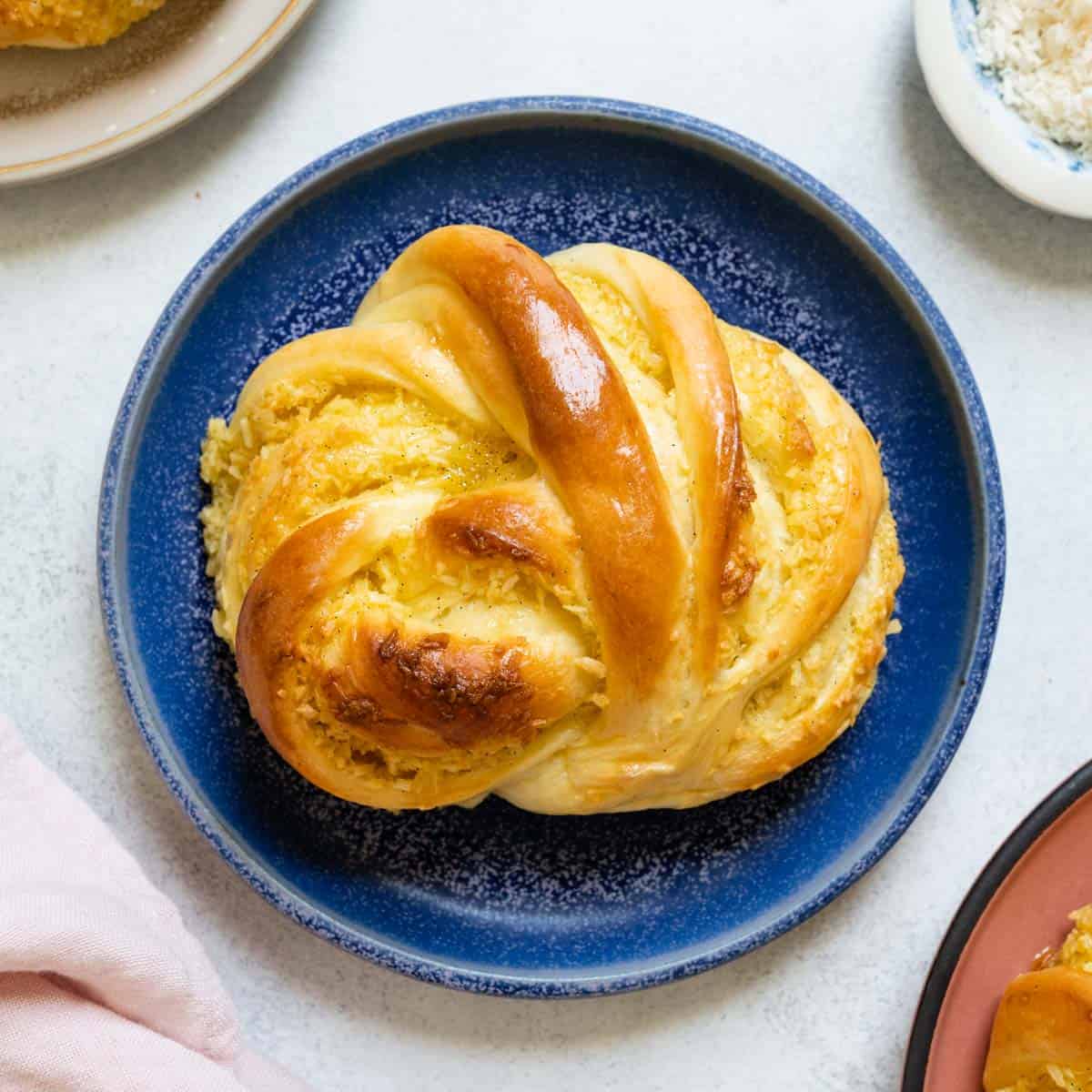

Thank you to Bob’s Red Mill for sponsoring this post!
This Chinese bakery-inspired coconut bun recipe has been a long time in the making. My initial inspiration came from a sliced coconut bread that Mama Lin used to buy from Chinese bakeries. The bread was like Japanese milk bread with ribbons of sweet coconut running inside and on top of the loaf. It was one of my favorite treats and I wanted to recreate that nostalgia at home.
However, trying to develop a recipe for that bread has proven to be more difficult that I imagined. Although I baked one loaf successfully, I haven’t been able to replicate that success. The loaves constantly cave inwards during the cooling process, probably from the weight of the filling.
For now, that recipe is on the back burner. Instead, I reconceptualized the coconut bread and turned it into 6 twisted coconut buns. The buns deliver a lot of fragrant flavor without being too sweet. The bread has hints of milky flavor. You also get coconut flavor from Bob’s Red Mill’s Unsweetened Shredded Coconut and rich vanilla notes from vanilla bean paste.
One quick note before I get to the recipe: these coconut buns are not the same as Chinese cocktail buns (雞尾包). The filling in cocktail buns are usually more moist and sweet. Also, they usually don’t have vanilla flavor.
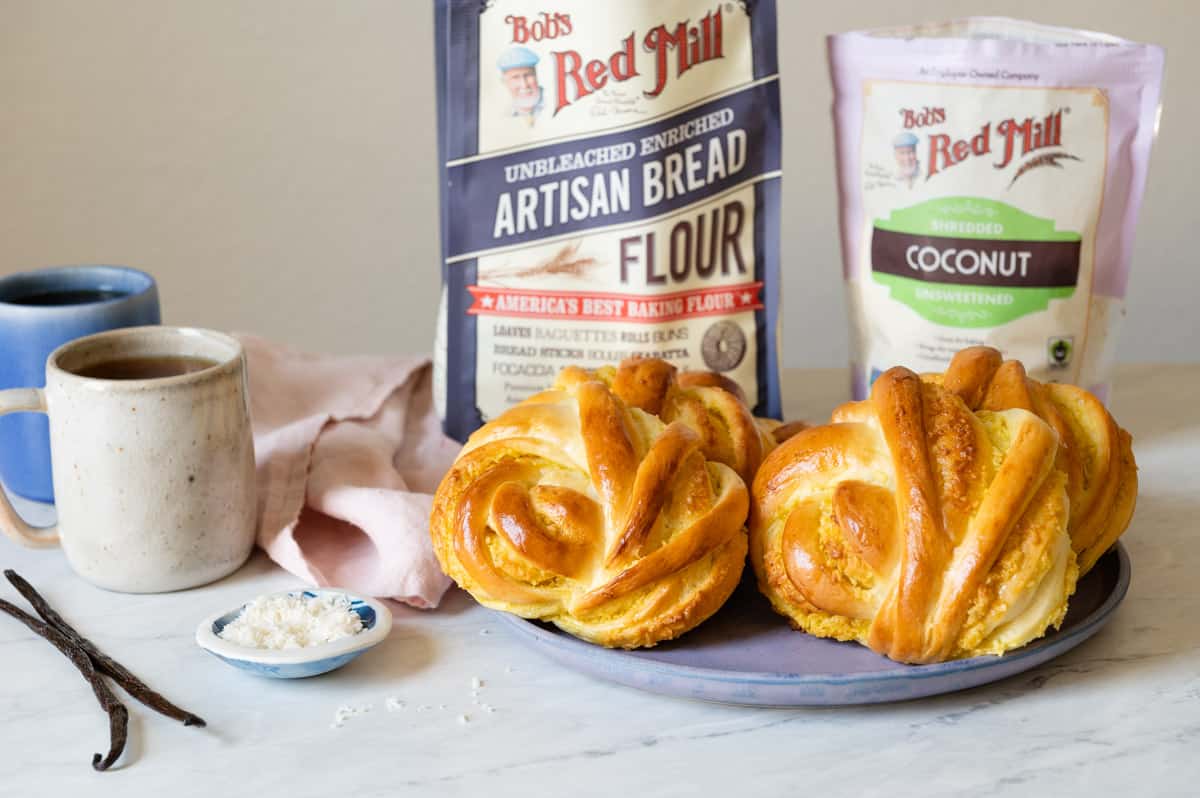
HOW TO MAKE COCONUT BUNS
INGREDIENTS FOR THE DOUGH
For the dough, you’ll need Bob’s Red Mill’s Artisan Bread Flour. If you are familiar with my Asian bread recipes, you’ll know how much I love using Bob’s Red Mill’s flour for my bakes. The texture of my breads are consistently good when I use Bob’s Red Mill’s flours. Moreover, their flours are usually easily accessible in grocery stores. Here are several other bread recipes that I developed using Bob’s Red Mill flours: Japanese milk bread, pineapple buns (bolo bao), and baked scallion bread.
In addition to bread flour, you’ll need whole milk, sugar, yeast, powdered milk, melted unsalted butter, and an egg. I prefer whole milk because it gives the bread richer flavor and the fat content helps make the bread soft. The powdered milk enhances the milky flavor of the bread. In my other bread recipes, I’ve used condensed milk instead of powdered milk and sugar. Many people have asked me for a dough recipe that doesn’t use condensed milk. That’s why I developed this version using powdered milk instead. Plus, leftover powdered milk is easier to store for a long time.
ACTIVATE THE YEAST
The first step in making the dough is activating the yeast. To do that, pour the milk into a microwave-safe bowl or a measuring cup and heat on high for about 30 seconds. The milk should be warm but not scalding hot, somewhere between 100ºF to 115ºF. In previous recipes, I said that the milk should be between 110ºF to 120ºF. Having baked more of this style of bread, I’ve found that it’s okay if the milk is slightly cooler.
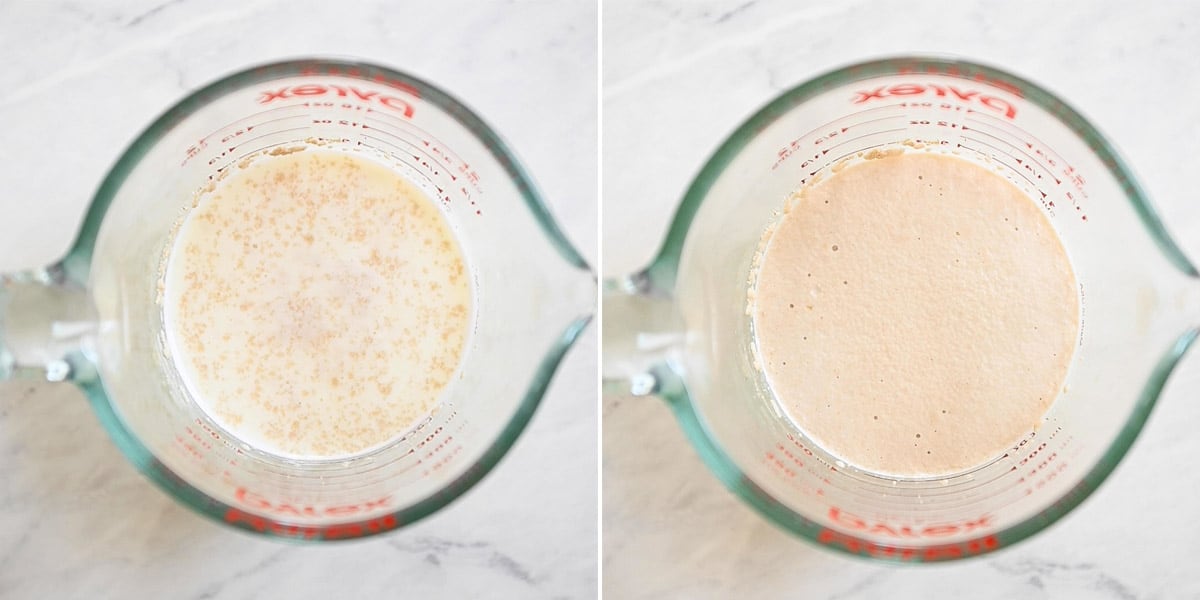
Once you heat the milk, add 35 grams (3 tablespoons) of sugar and the yeast to the warmed milk and stir together. Technically, you don’t need to use all that sugar to activate the yeast. However, I can be forgetful and will omit the remaining sugar later on if I don’t deal with the sugar at once. Let this milk and yeast mixture sit for 5 minutes. After the resting period, the yeast develops a thin foamy layer at the top (see photo above, right), which is an indication that the yeast is active. If you don’t see any foaming activity at all, your yeast may have expired.
USING INSTANT YEAST
If you are using instant yeast, you do not need to activate it. In other words, you do not need to heat the milk and mix the yeast with the milk. Simply add the instant yeast along with the other ingredients for the dough into the bowl of your stand mixer. Then, start mixing and kneading the dough. Note that if you used milk straight out of the fridge, dough might not rise as high because the dough is colder.

MAKE THE DOUGH
When you have measured and prepared all the ingredients for the dough, add them into the bowl of your stand mixer. Mix the dough on low until you don’t see any loose flour on the sides of the bowl. This should take 30 seconds to 1 minute. If you start out using a high speed to mix the flour, the flour will fly out all over your counter.

Next, increase the speed to medium-low and work the dough for 8 minutes. The dough will wrap around the dough hook. Once the dough has mixed for 8 minutes, it should feel supple and lightly moist. However, the dough shouldn’t stick to your fingers when you squeeze it and let go.
Even though I provide weighted measurements for the ingredients, I know we all work in different kitchen conditions, which can affect the hydration levels of the dough. If the dough feels very sticky when you squeeze it with your fingers, add another tablespoon of bread flour and work the flour into the dough. Then test the texture of the dough again with clean hands. If the dough is still very sticky, add another tablespoon of flour and work it in. Conversely, if the dough is dry (and you can tell because the dough isn’t wrapping around the dough hook consistently), add 1 tablespoon of milk and work it into the dough.
Scrape the dough out of the bowl onto a surface and knead a few times. I don’t usually flour the work surface because the dough doesn’t stick to my hands or the work surface. If the dough is still feeling sticky, lightly dust your work surface and knead the dough several times.
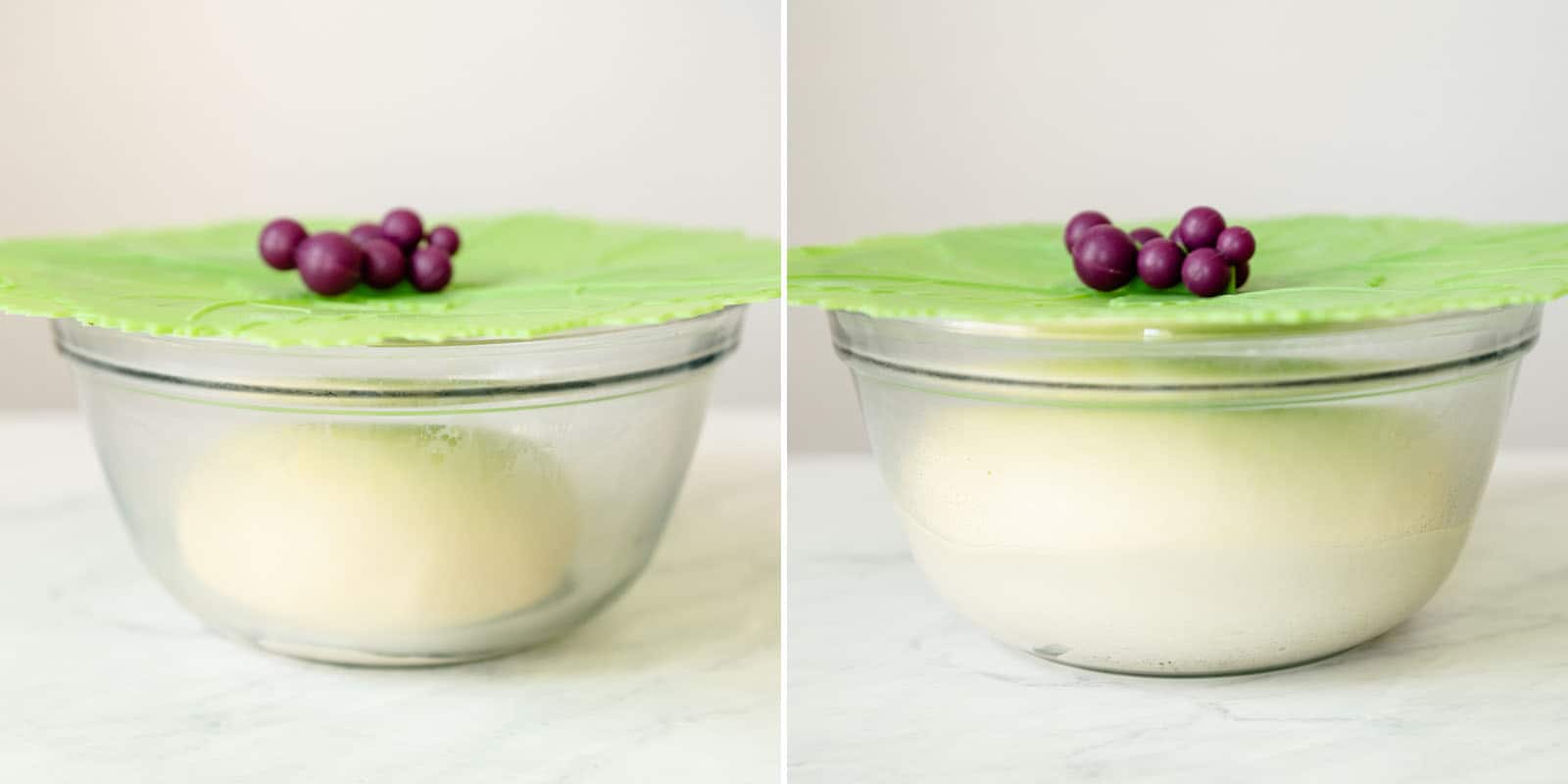
Shape the dough into a ball and place the dough inside a greased mixing bowl (photo above, left). Cover the bowl with a damp towel (or a silicone lid) and let it rise in a warm place for about 1 hour, until the dough doubles in size (photo above, right).
A DOUGH WITHOUT TANGZHONG
If you have made my other Asian bread recipes, you’ll know that I generally use tangzhong, a paste made of water and flour heated together. Tangzhong gives bread a soft and pillowy texture.
When I tested this coconut bun recipe, I noticed that the tangzhong-based dough puffed up too much during the second rise and while the buns baked. As a result, the twisted knot in the coconut buns would unravel or lose its definition. That’s why I decided to omit the tangzhong here. To ensure that the buns are soft, I’ve included adequate amounts of fat from the butter and whole milk.
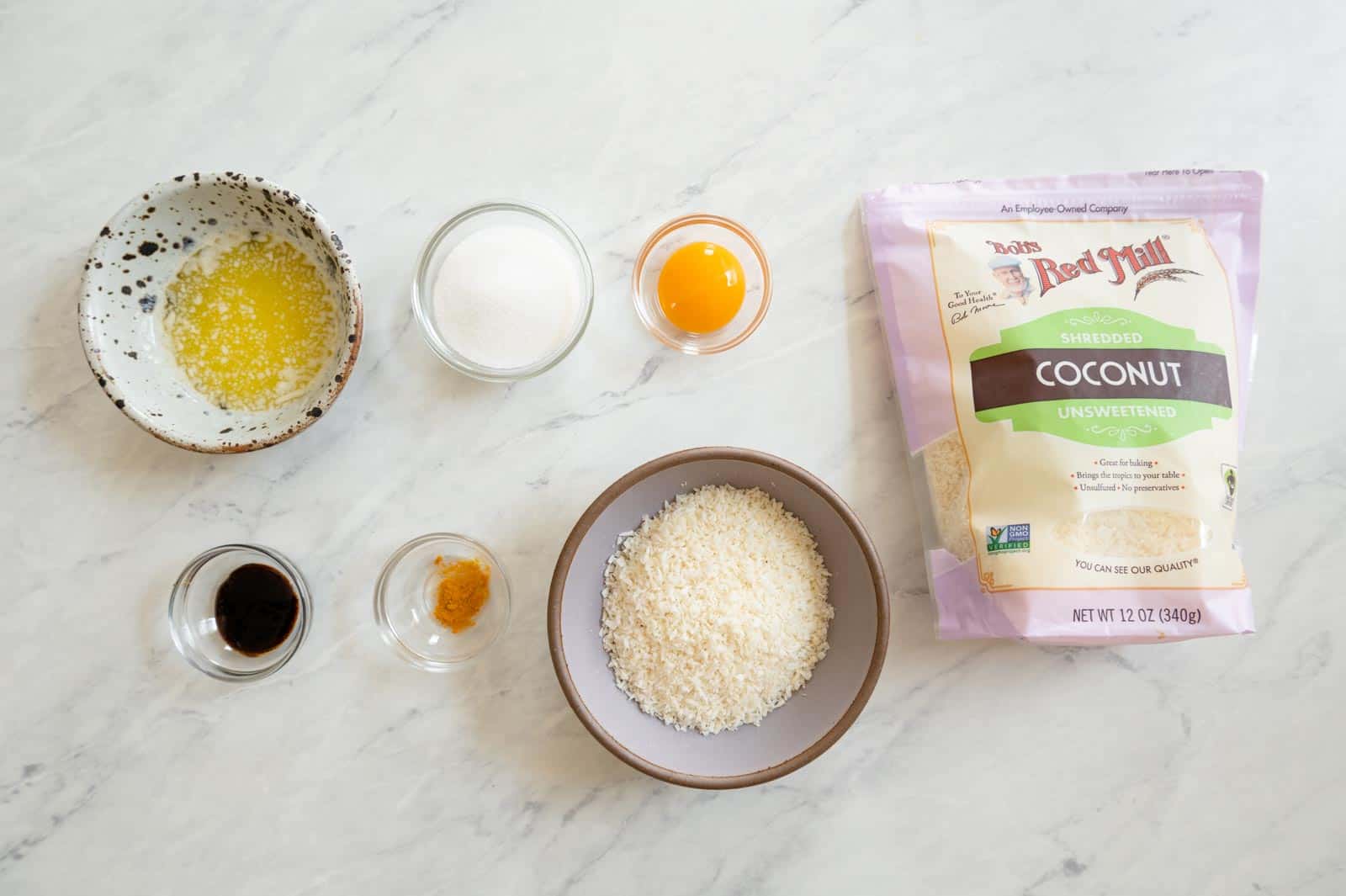
MAKE FILLING
The filling consists of Bob’s Red Mill’s Unsweetened Shredded Coconut, sugar, ground turmeric, melted unsalted butter, an egg yolk, and vanilla bean paste. I love the way the texture of the shredded coconut contrasts with the soft texture of the buns. To enhance the yellow color of the filling, I added a trace amount of ground turmeric to the filling (1/16 teaspoon). However, you can omit the turmeric if you don’t like it. I also wanted a strong vanilla flavor in the buns, so I used vanilla bean paste for the filling. If you don’t have vanilla bean paste, you can use vanilla extract instead.
After you mix the ingredients for the filling, chill the filling in the fridge for 20 to 25 minutes. It’ll make the bun shaping process less messy later. The filling can harden in the fridge if you leave the bowl uncovered for a longer period (over an hour). If it hardens, let the filling sit out at room temperature for 20 minutes or so to soften it slightly. You can also cover the bowl, which helps to keep the filling from stiffening.
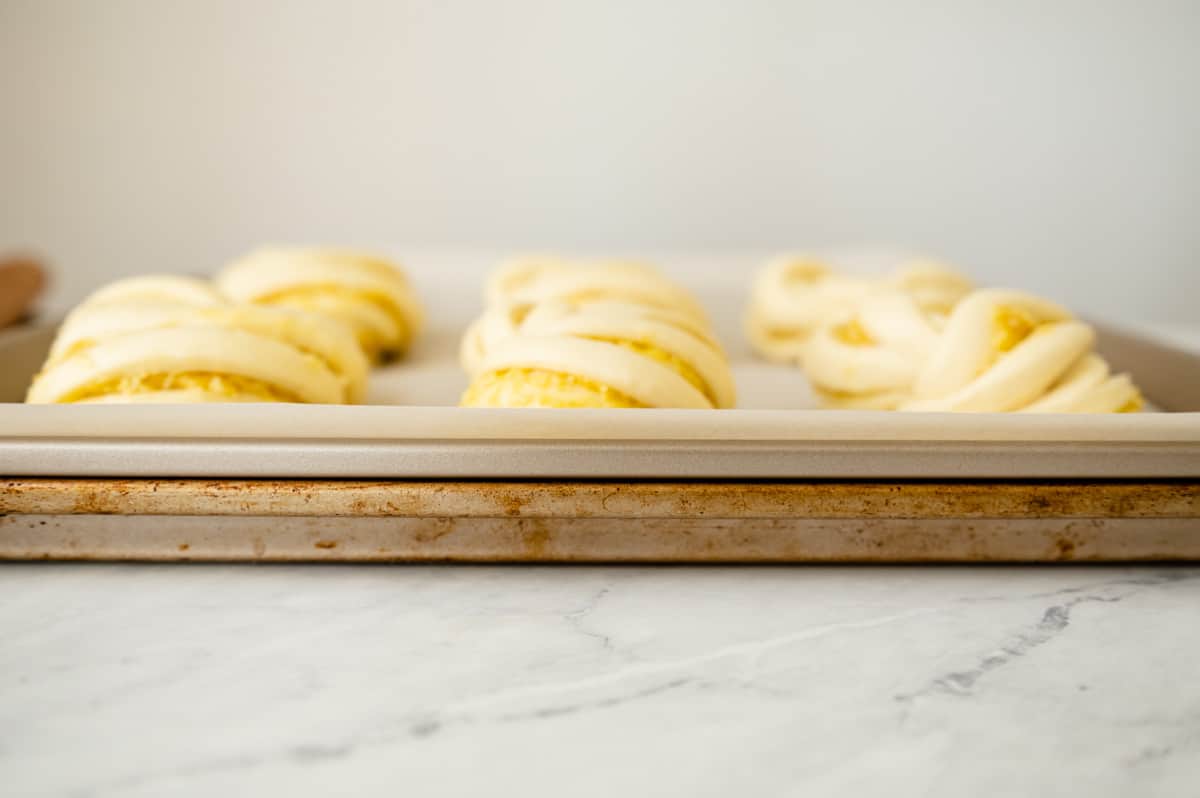
PREPARE BAKING SHEETS
Line a large sheet pan (13×18 inches or larger) with parchment paper. If you have another baking sheet of the exact same size, I recommend stacking it underneath the lined baking sheet. When you stack 2 baking sheets of the same size, the rims of the sheets will touch, but there will be a gap between the top and bottom sheets. The gap helps to keep the bottoms of the buns from overbrowning.
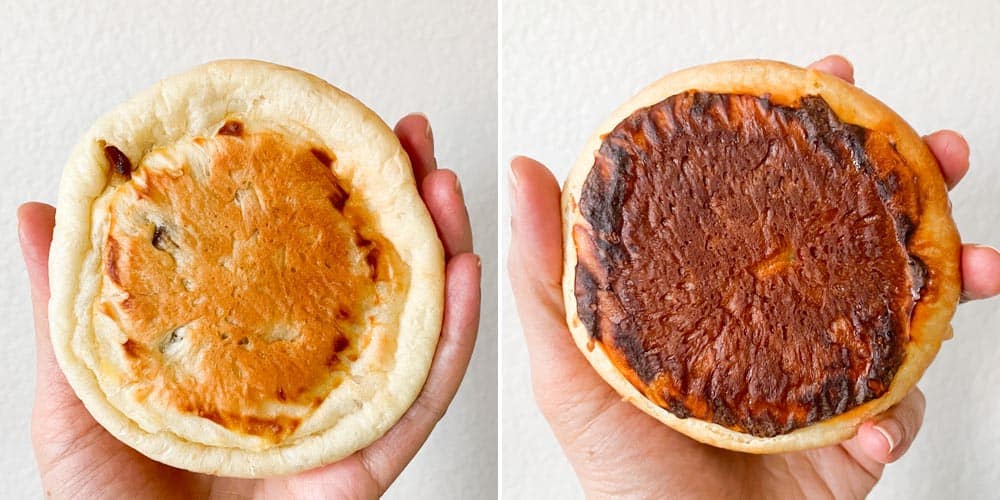
You can see from this experiment I did with my baked Chinese BBQ pork buns the difference the sheet stacking makes. The bun on the left was baked on stacked sheets while the one on the right was baked on a single sheet.
SHAPE THE BUNS (VIDEO DEMONSTRATION IN RECIPE CARD)

Take the chilled filling and divide it into 6 equal pieces of about 25 to 28 grams each, about 1 1/2 tablespoons. I usually use a medium cookie scoop to divide the filling.
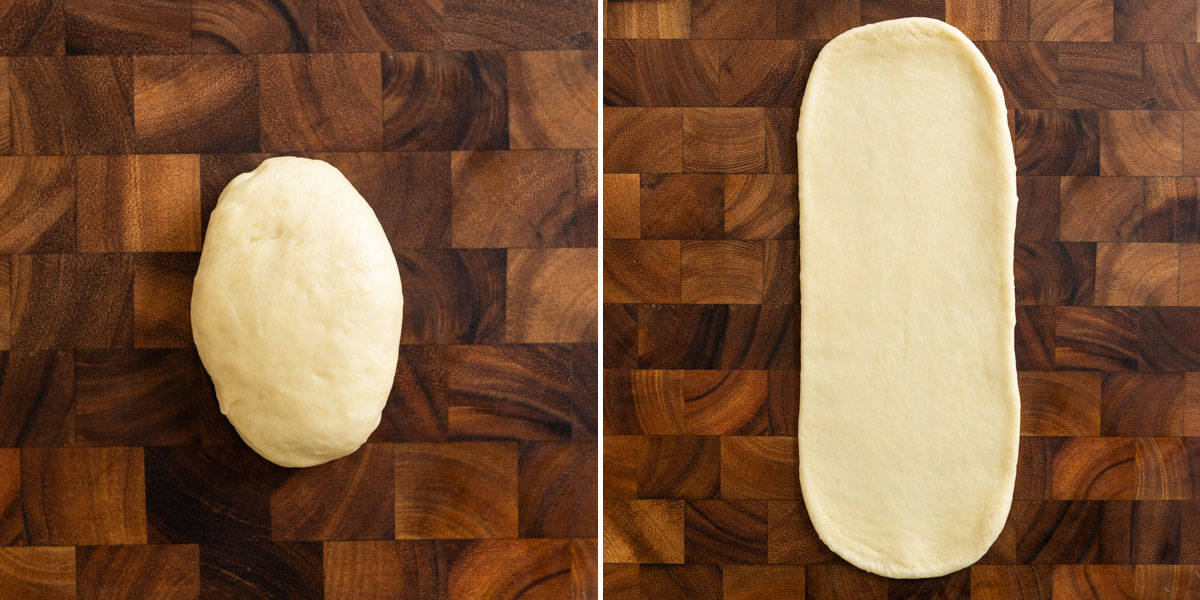
Punch down the risen dough to remove excess air. Divide the dough into 6 equal pieces of about 112 to 115 grams each. Shape the dough into an oval. Cover 5 pieces of dough with a dry towel while you shape the first bun.
Roll out one piece of dough until you get a rectangle of about 10 to 10.5 inches long and 4 to 4.5 inches wide. I don’t usually flour the surface before I roll out the dough. When I dust the surface with flour, the dough often shrinks back as I roll it out, especially in the beginning. However, when rolling the dough on a bare surface, the dough grips onto the surface easier and it doesn’t shrink back as easily.
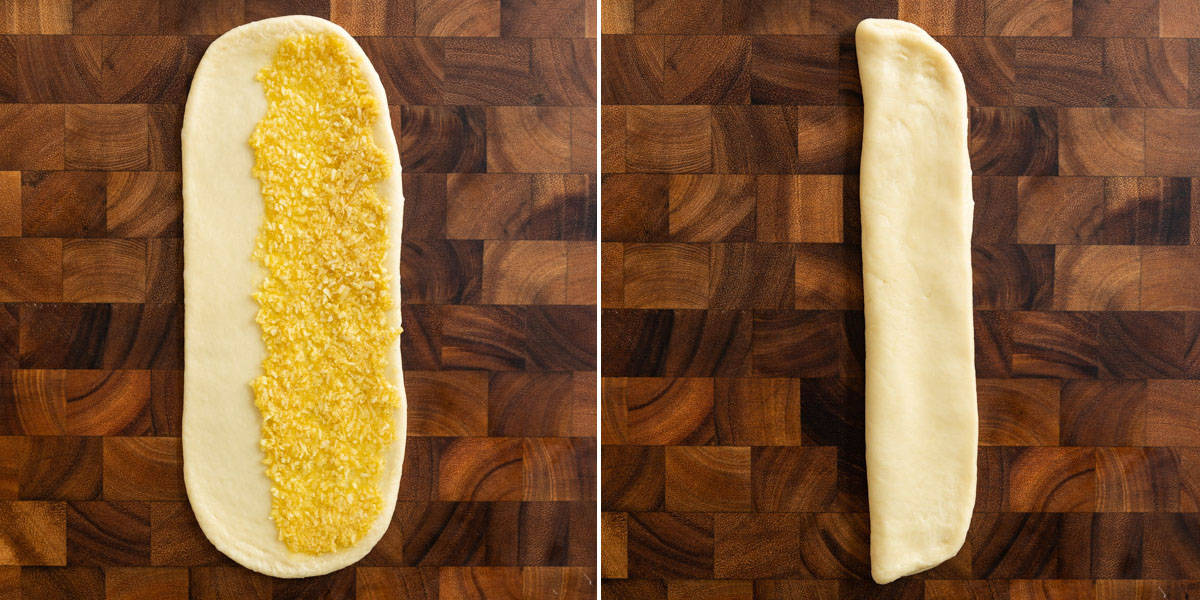
Take 1 piece of the filling and spread it over half of the rectangle, along the length of the rectangle. See photo above, left, for reference.
Fold the side of the rectangle without filling over the half with filling. You should have a long and thin rectangle. The rectangle might look a bit lopsided, but don’t worry too much about it. You won’t notice the imbalance once you shape the bun into a knot.
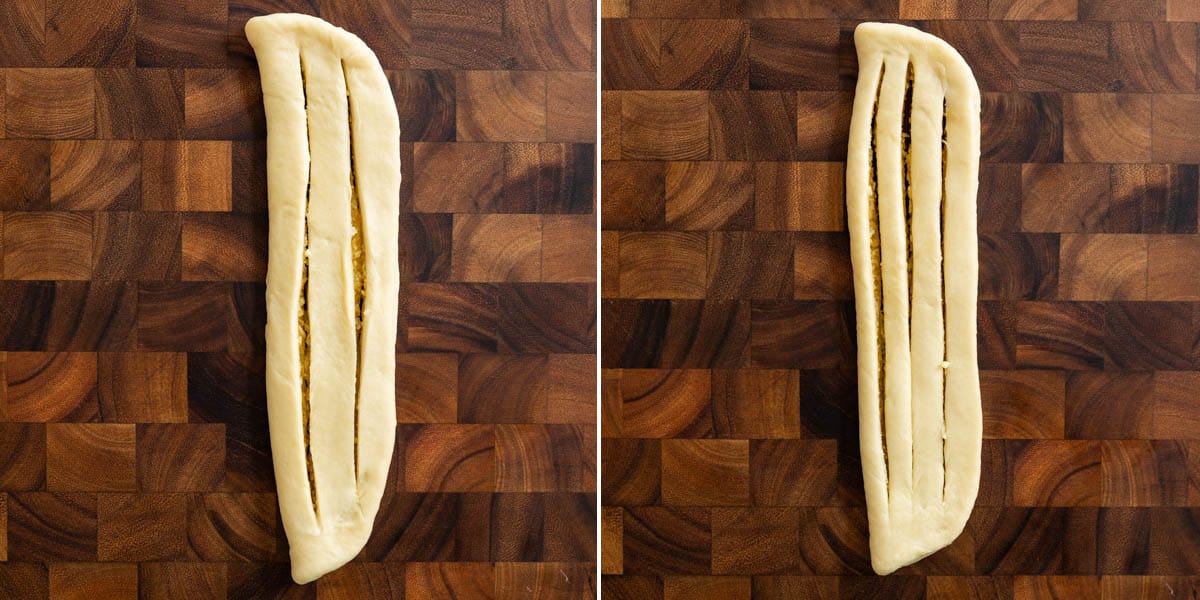
Using a knife, make 2 or 3 long cuts inside the rectangle, leaving 1/4 to 1/2 inch border along the short side of the rectangle uncut. The border ensures that the strips are attached together, making the next step easier. By now, you should have created 3 or 4 strips inside the rectangle, depending on how many cuts you made.
When testing the recipe, I thought that the pattern of the coconut buns would look more intricate with 4 strips instead of 3. However, once you twist the dough and tie it into a knot, you can barely tell the difference between the two versions. The dough is easier to handle when you make only 2 cuts inside the rectangle, but feel free to experiment with both methods.
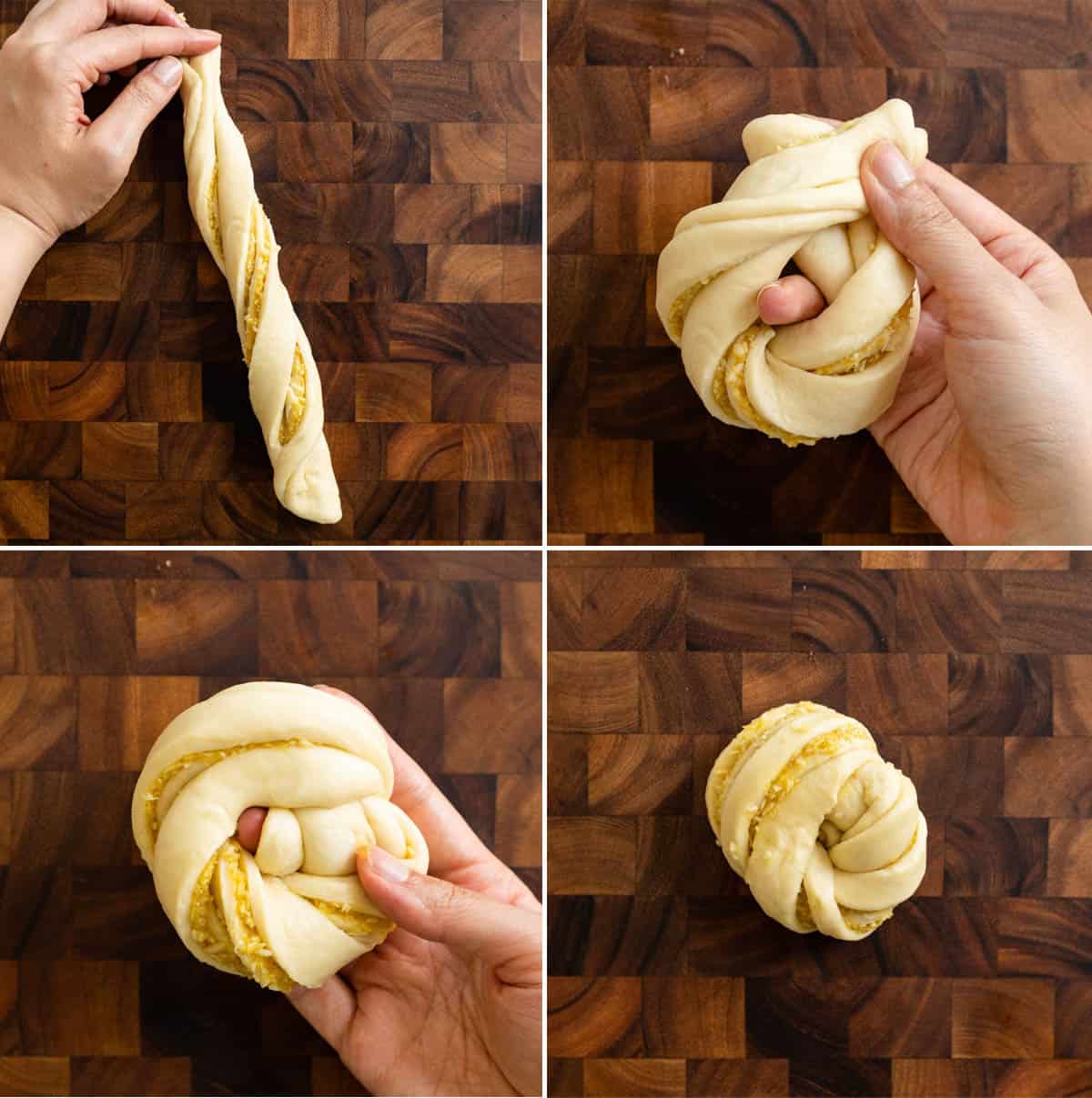
Grab a hold of the short ends of the dough and twist it several times. Then tie the twisted dough into a knot (see the photos above or the video in the recipe card for reference). Transfer the knotted dough onto the lined baking sheet. Continue shaping the remaining pieces of dough.
Cover the knotted buns with a layer of plastic wrap and let the buns rise for an hour, until they double in size.

BAKE COCONUT BUNS
Once the buns are nearly done rising, preheat the oven to 350ºF. Position an oven rack to the center position.
Whisk an egg with 1 tablespoon of milk for the egg wash. If you don’t want to crack open another egg for the egg wash, you can actually use the leftover egg whites reserved from the filling. Thin out the whites with 1 teaspoon of milk. The buns won’t look as golden once they’re baked, but the whites will add some color to the buns.
Gently apply a thin layer of egg wash over the risen buns. Place the coconut buns in the oven and bake for 22 to 25 minutes, until they are golden brown at the top. I like to rotate the baking sheet after 15 minutes to ensure even browning.
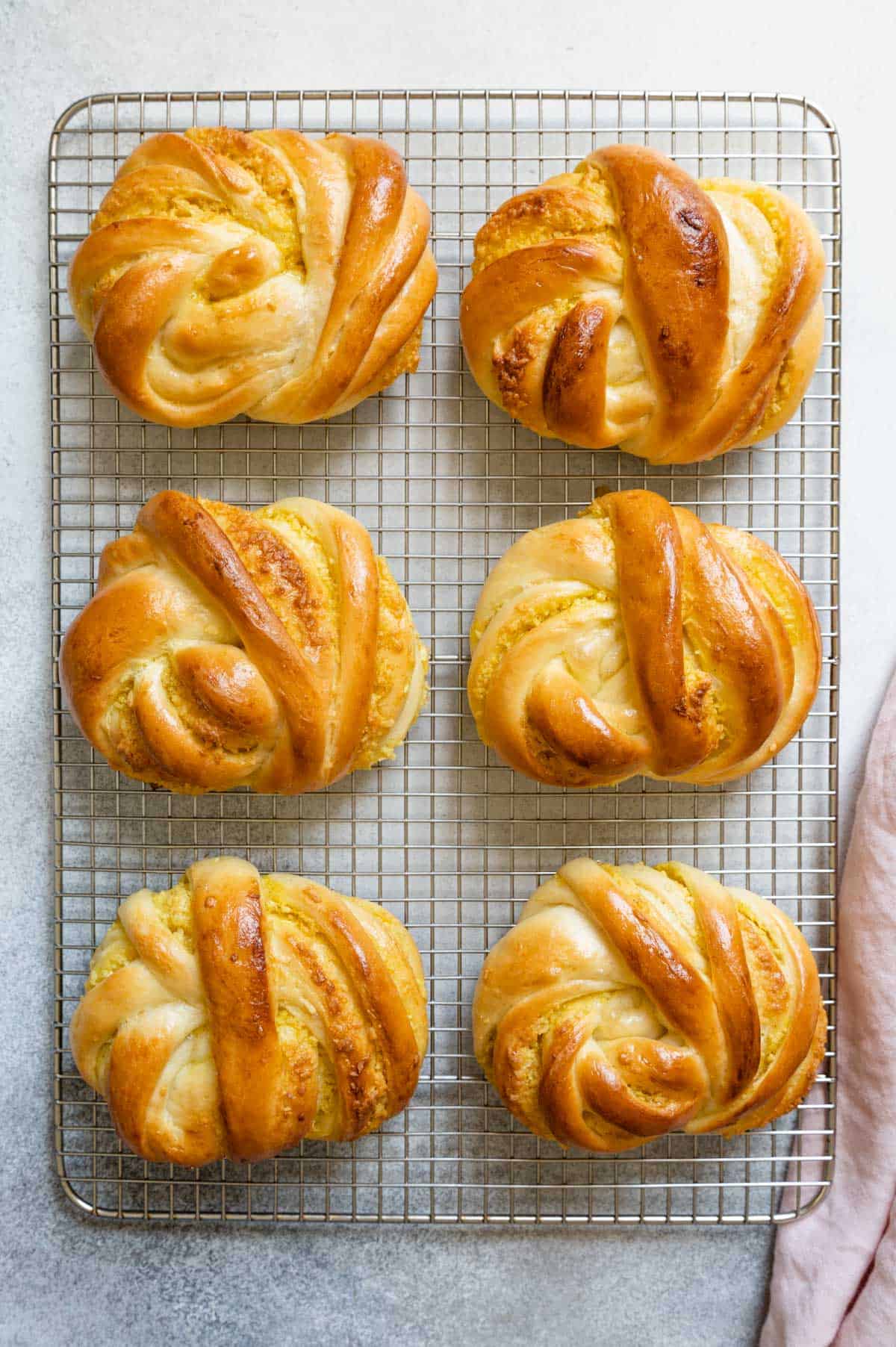
Take the coconut buns out of the oven. Let them cool on the baking sheet for 5 minutes before transferring them to a cooling rack. These coconut buns are best consumed while they’re still a little warm.
WHAT TO DO WITH LEFTOVER EGG
I usually combine the leftover egg whites and egg from the egg wash. I’ll either scramble them on their own or use it for fried rice.

MAKE AHEAD DIRECTIONS FOR COCONUT BUNS
You can make the dough and the filling a day ahead. Right after you have worked the dough in the mixer for 8 minutes, transfer the dough to a greased mixing bowl. Then, cover the bowl with plastic and transfer to the refrigerator to rise overnight. You DO NOT need to let the dough rise on your counter first. Similarly, once you have mixed all the ingredients for the filling, transfer the filling into a container and refrigerate.
When you are ready to make the buns the next day, take the filling out of the fridge and touch it to test the texture. If it is rock solid, let it sit on your counter for 25 to 30 minutes to soften slightly. Once the filling feels more malleable, you can take the dough out of the fridge and shape the coconut buns. You shouldn’t need to warm up the dough before rolling it out. However, if you find the pieces of dough are constantly shrinking back as you roll them out, let the dough sit for 15 to 20 minutes before continuing to roll them out.
STORING AND REHEATING COCONUT BUNS
I usually store the baked buns in a container and leave them out on my counter. They should keep for 2 or 3 days. If you don’t think you can finish the coconut buns within 2 or 3 days but will consume them within a week, store the coconut buns in the refrigerator. When you are ready to eat the buns, heat them in the microwave on high for 10 to 20 seconds. This is the easiest way to reheat the coconut buns while maintaining their soft texture.
CAN I FREEZE THESE BUNS?
Yes. If you want to keep the buns for longer than a week, freeze the baked buns and store them in a freezer bag. When you are ready to heat them, bake the frozen buns at 350ºF for 10 to 12 minutes. You do not need to thaw them beforehand.

Coconut Buns (椰絲包)
Ingredients
Dough
- oil for greasing bowl any neutral flavored oil
- 175 grams whole milk 3/4 cup
- 35 grams sugar 3 tablespoons
- 3 grams active dry yeast 1 teaspoon
- 360 grams bread flour 3 cups measured with spoon and sweep method (see note 1)
- 5 grams powdered milk 1 tablespoon
- 2 grams kosher salt 1/2 teaspoon
- 55 grams unsalted butter melted
- 1 large egg
Coconut Filling
- 50 grams unsweetened shredded coconut 1/2 cup
- 40 grams sugar 3 tablespoons plus 1 teaspoon
- 1/16 teaspoon ground turmeric (optional) (see note 2)
- 40 grams unsalted butter 3 tablespoons, melted
- 1 egg yolk from a large egg
- 6 grams vanilla bean paste 1 teaspoon, can substitute with vanilla extract
Egg Wash (see note 3)
- 1 egg
- 1 tablespoon milk
Instructions
Make the Dough
- Lightly grease a large mixing bowl with oil. Set it aside.
- In a microwave-safe bowl, heat the milk in the microwave on high for about 30 to 35 seconds. Use a thermometer to check the temperature of the milk. It should be somewhere around 100ºF to 115ºF. If the milk is too hot, quickly whisk the milk and let it cool for several minutes.
- Add the sugar and yeast to the milk. Stir to hydrate the yeast. Let it sit for 5 minutes while you prepare the other ingredients. After 5 minutes, you should see a layer of foam on the top (an indication that the yeast is active).
- In the bowl of a stand mixer, add the bread flour, powdered milk, salt, foamy milk/yeast mixture, melted butter, and egg.
- Fit the mixer with the dough hook. Mix the dough on low until you don’t see any loose flour on the sides of the bowl. This should take 30 seconds to 1 minute. Then, increase the speed to medium-low and work the dough for 8 minutes. The dough should feel supple and moist but not overly sticky. If it is very sticky, add another tablespoon of flour and work the flour into the dough. (See note 4)
- Scrape the dough out of the bowl onto a surface and knead a few times. If the dough is feeling tacky, lightly dust the surface with flour and continue kneading a few times.
- Shape the dough into a ball and place inside the greased mixing bowl. Cover the bowl with a damp towel (or a silicone lid) and let it rise in a warm place for about 1 hour, until the dough doubles in size.
Make the Filling
- In a bowl, mix the coconut, sugar, and turmeric. Then, add the melted butter, egg yolk, and vanilla bean paste. Mix everything together until combined.
- Transfer the bowl to the refrigerator to chill the filling while the dough rises (about 20 to 30 minutes). If you leave the bowl inside the fridge uncovered for over an hour, the filling can harden. Either keep an eye on the time or cover the bowl before refrigerating.
Shape the Buns
- Stack 2 large baking sheets of the same size (13” x 18” or larger). Line the top sheet with parchment paper. Stacking the baking sheets ensures that the bottoms of the buns won’t brown too much. (See note 5 for more information)
- Take the chilled filling out of the refrigerator and divide it into 6 pieces of about 25 to 28 grams each (about 1 1/2 tablespoons). I usually use a medium cookie scoop and measure out a scant scoopful of filling for each piece.
- Punch down the dough to release excess air. Divide the dough into 6 equal pieces, about 112 to 115 grams each. Shape the dough into an oval. Cover 5 pieces of dough with a towel while you shape the first bun.
- Roll out one piece of dough until you get a rectangle of about 10 to 10.5 inches long and 4 to 4.5 inches wide. I don’t flour the surface before I roll out the dough. This way, the dough grips onto the surface as I roll it out without shrinking back significantly.
- Take 1 piece of the filling and spread it over half of the rectangle (along the long edge). See photos in the blog post or the video below for reference. Pick up the side of the dough without filling and fold it over the half with the filling. You should now have a long and thin rectangle. It’s okay if the rectangle doesn’t look perfect at this stage.
- Using a knife, make 2 or 3 long cuts inside the rectangle, leaving 1/4 to 1/2 inch border along the short side of the rectangle uncut. The border ensures that the strips are attached together, making the next step easier. By now, you should have created 3 or 4 strips inside the rectangle. It’s up to you how many cuts you want to make as I think the finished buns look very similar either way.
- Grab a hold of the short ends of the dough and twist the dough a few times. Then tie the dough into a knot (see video below or photos in the blog post for reference).
- Transfer the knotted dough onto the lined baking sheet. I also like to make sure that some of the coconut filling is exposed by opening up lightly pulling apart some of the layers of the twisted bun. Continue shaping the remaining pieces of dough into buns.
- Cover the knotted buns with plastic wrap and let the buns rise for an hour, until they double in size.
Bake
- When the second rise is nearly done, preheat the oven to 350ºF. Position an oven rack to the center position.
- Whisk an egg with a tablespoon of milk. Gently apply a thin layer of egg wash over the risen buns. (See note 6 for what to do with leftover eggs).
- Place the coconut buns in the oven and bake for 22 to 25 minutes, until they are golden at the top. I like to rotate the baking sheet after 15 minutes to ensure even browning.
- Take the coconut buns out of the oven. Let them cool on the baking sheet for 5 minutes before transferring them to a cooling rack. These coconut buns are best consumed while they’re still a little warm.
Storing Baked Buns
- I usually store the baked buns in a container and leave them out on my counter. They should keep for 2 or 3 days. If you don’t think you can finish the coconut buns within 2 or 3 days but will consume them within a week, store the coconut buns in the refrigerator. When you are ready to eat the buns, heat them in the microwave on high for 10 to 20 seconds. This is the easiest way to reheat the coconut buns while maintaining their soft texture.
- Freezing: If you want to keep the buns for longer than a week, freeze the baked buns and store them in a freezer bag. When you are ready to heat them, bake the frozen buns at 350ºF for 10 to 12 minutes. You do not need to thaw them beforehand.
Video
Notes
- Spoon-and-sweep method of measuring flour: If you do not have a scale, use a fork to fluff up the flour in the bag or container. Then, use a spoon to scoop flour into the measuring cup, until it is overflowing with flour. DO NOT tap the measuring cup on the counter to try to get more flour into the measuring cup. Sweep the top of the measuring cup with a knife to level the flour. Finally, transfer the flour to the bowl of the stand mixer.
- To enhance the yellow color of the filling, I added a trace amount of ground turmeric to the filling. However, you can omit the turmeric if you don’t like it.
- If you don’t want to crack open another egg for the egg wash, you can actually use the leftover egg whites reserved from the filling. Thin out the whites with 1 teaspoon (instead of 1 tablespoon) of milk. The buns won’t look as golden once they’re baked, but the whites will add some color to the buns.
- Even though I provide weighted measurements for the ingredients, I know we all work in different kitchen conditions, which can affect the hydration levels of the dough. If the dough feels very sticky when you squeeze it with your fingers, add another tablespoon of bread flour and work the flour into the dough. Then test the texture of the dough again with clean hands. If the dough is still very sticky, add another tablespoon of flour and work it in. Conversely, if the dough is dry (and you can tell because the dough isn’t wrapping around the dough hook consistently), add 1 tablespoon of milk and work it into the dough.
- If you have another baking sheet of the exact same size, I recommend stacking it underneath the lined baking sheet. When you stack 2 baking sheets of the same size, the rim of the sheets will touch, but there will be a gap between the top and bottom sheets. The gap helps to keep the buns from over-browning at the bottom.
- I usually combine the leftover egg whites and egg from the egg wash. I’ll either scramble them on their own or use it for fried rice.
Nutrition
Disclosure: This post was sponsored by Bob’s Red Mill! To learn more about their products and to get more recipe inspiration, follow them on Instagram or Facebook.
The post Coconut Buns (椰絲包) appeared first on Healthy Nibbles.

